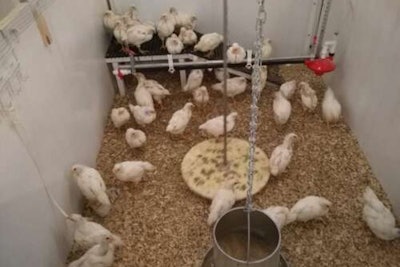
At long last, the results of a study that examines welfare outcomes from conventional broiler breeds and slower-growing breeds have been released.
Researchers at the University of Guelph (U of G) in Ontario, Canada, conducted the study.
The short answer concerning the study’s outcome was pretty well highlighted in the first paragraph of a press release issued by the university on September 9.
“Raising slower-growing broiler chickens means less efficiency for producers and potentially higher costs for consumers, but it would improve the welfare of millions of birds,” the release stated.
While most people in the industry have already known that raising slower-growing broilers would be a less efficient way to produce protein and that the consumer costs for the end poultry products would likely be higher, there was still some question concerning the validity of the claims that slower-growing breeds actually had better welfare outcomes.
“We found that, overall, many indicators of welfare are directly related to rate of growth,” said Tina Widowski, professor at the university's Department of Animal Bioscience.
Widowski, according to the press release, led the team of researchers that included a team of university experts in poultry welfare, nutrition, physiology and meat science.
The researchers studied more than 7,500 chickens raised at the U of G Arkell Research Station, looking at 16 genetic strains bred for four growth rates. Birds were outfitted with wearable devices similar to Fitbits, and were evaluated for their mobility and activity. The study also included use of an obstacle test that helped the team to compare leg strength among different poultry breeds. Birds were also monitored for their use of enrichments, and were examined for foot lesions and meat quality.
The release stated that faster-growing chickens were less active and mobile, had poorer foot health and had more breast muscle damage.
At the same time, researchers learned that health and welfare issues that were more common 20 years ago, such as skeletal leg muscle problems and heart failure, are no longer prevalent.
“That means breeder selection to resolve those problems has worked,” Widowski said.
Where will the industry go from here?
With the results of this study released, it could be a turning point for the U.S. poultry industry. Or at least it will prompt some integrators to re-evaluate the breeds of birds they use. Some are already going the slower-growing route, while others have expressed a willingness to transition a percentage of their production to such birds.
Slower-growing broilers have been advocated by the Global Animal Partnership (GAP), as well as animal rights groups – some of which are represented on the GAP board. Those groups have lobbied a significant number of businesses to sign pledges to transition their supply to exclusively use breeds and production/processing techniques approved by the GAP. A commitment tracker webpage shows that more than 180 businesses in the United States and Canada have made such pledges.
The U of G press release says the research team “hopes the study will help poultry breeders and producers to select traits associated with better welfare.”
But it’s not that simple.
Will the consumers be willing to pay more for the end product if they believe the animals were more comfortable while on the farm? The less-than-stellar demand for cage-free eggs, also promoted as coming from chickens whose welfare was better than caged hens, indicates the majority of them will not.
That, and the added costs of production, are key factors that must be considered.
More information forthcoming
In a separate press release, GAP said a summary of the study results is available on the GAP Better Chicken Project webpage, which represents what it calls “key parts of the research.” GAP also said additional analysis and further data will be released.
GAP also said a multi-stakeholder technical working group of experts has been assembled to assist it with drafting protocols for assessing broiler breeds for use in the GAP program.
U of G researchers who worked on the study are now in the process of preparing a series of peer-reviewed articles. It is anticipated that those articles will be published within the next year.
The U of G study was financed by GAP, the U of G Food from Thought project and the Ontario Ministry of Agriculture, Food and Rural Affairs.


















